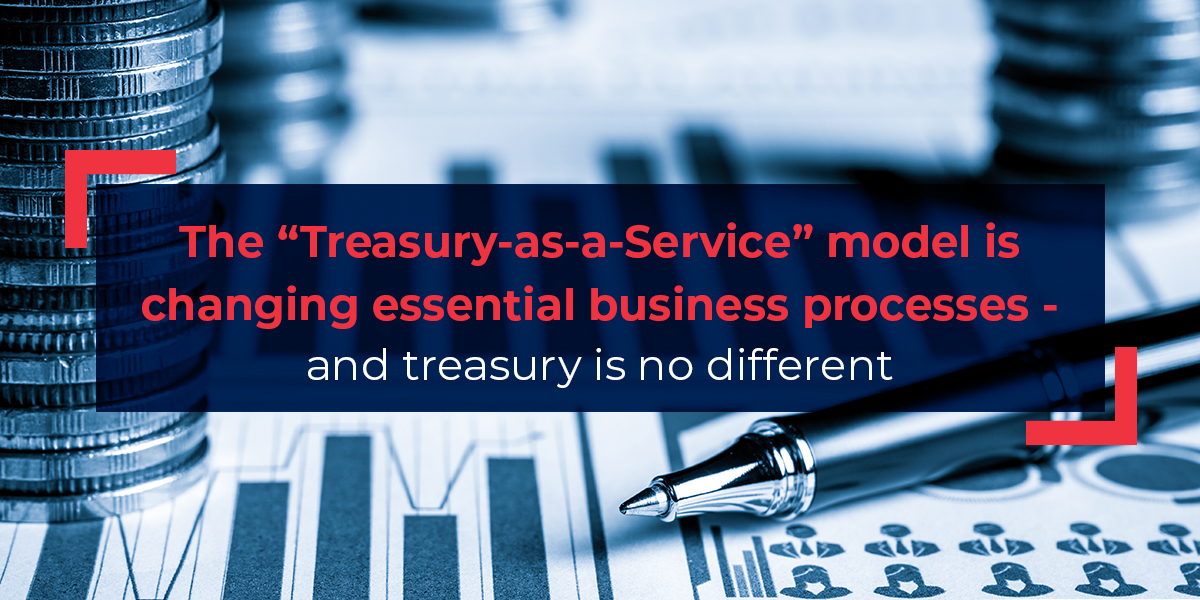
The TaaS model is changing essential business processes
Like many roles in business, treasurers want to be free of repetitive, tedious manual jobs and instead focus their energy on high-value activity that delivers real business benefits to the company. After all, they’re responsible for managing liquidity and hedging risk; and also play a key role in planning their company’s financial direction and devising a sound strategy that safeguards liquidity and boosts profitability.
Software-as-a service (SaaS) has made the lives of treasurers far easier: cloud-based solutions today give them access to data at the touch of a button, in real-time, regardless of their location.
Even with automation by means of a treasury management system (TMS), companies might still be left with daily tasks that exceed their capacities. Fortunately, technology has progressed so that if you have a treasury set up but want to focus on high-value activity and decisions; or if you don’t have a treasury but would still like to benefit from the added value that treasury data and management can bring, the answer is outsourcing via Treasury-as-a-Service (TaaS).
TaaS is much more than technical support. Instead, its purpose is to streamline the function of the modern treasury and boost its performance by eliminating inefficient and repetitive tasks that can easily be performed by someone else who is familiar with the system and understands treasury processes.
That said, treasurers must be able to stay on top of these decisions by having complete visibility and using it to their strategic advantage. Transparent TaaS solutions provide clearer, more up-to-date information for analysis, while the latest artificial intelligence (AI) technology collates far larger data sets than previous rules-based logic systems. With the right set-up, TaaS can use AI to process and visualise data on the timing of payment runs, recorded customer payment behaviour, historical patterns, rebate schedules and more, to create more accurate forecasts more quickly than was possible previously.
Treasurers need accurate data and results, especially when it comes cross-border payments. There are of course specific treasury services a company might require depending on its size and strategy. There are a number of non-mission critical and non-core competence processes in treasury. In theory, TaaS can cover any corporate treasury operation and can be made to fit any functionality required. It is a question of capacity, focus and, ultimately, preference.
In terms of FX management, currency conversion and hedging can also start shifting to real time via TaaS. Traditionally, cross-currency transactions are handled through batch processing, putting investors at risk of rate fluctuations and obscuring conversion rates. Until FX conversion and hedging are also treated in real-time, multinational corporations working in multiple currencies will not realize the full benefits of real-time payments.
There is a frequent disconnect between cross-currency conversion and the booking process in terms of when the payment is executed and what rate is used. Real-time technology can provide unprecedented visibility over a traditionally opaque part of Treasury by time-, date-, and rate-stamping each conversion.
Real-time technology and artificial intelligence can also be combined to execute hedges based on user-defined rules.
Every company has in place certain tedious, recurring treasury processes that you simply don’t want your treasury staff spending their time and energy on. Moreover, you might have more complex requirements that mean having to buy in outside expertise. Or you may not even have a treasury in the first place.
The advantage of TaaS is its flexibility to support multiple roles in a corporate’s front, middle or back office, including:
- operative maintenance of master data
- regular system-data verification and maintenance
- account statement collection
- account verification
- daily financial status reporting
- automation control and error resolution
- monitoring liquidity forecasting
- concluding FX hedges based on predefined hedge ratios
- monitoring multilateral reconciliation processes
- cross border payment verification
- performing netting runs
A treasury and finance department’s liquidity management is essential to its performance. As we have seen in the past, people overlook a company’s cash flow at their peril. As its name implies, liquidity management is the concept of immediate access to readily available cash for funding short-term investments, paying off debts, and paying for goods and services.
What’s important is that finance and treasury managers look at the company’s balance sheet and convert funds that are tied up in longer-term projects into cash that can be used for day-to-day operations.
Keeping tabs on the firm’s liquidity risk requires managers to track its liquidity ratio, in which liquid assets (those that can be converted into cash quickly and easily) are compared with short-term liabilities or near-term debt obligations. It is impossible to overstate the importance of liquidity management. Downplaying liquidity risk can result in the added cost of an unrealized opportunity.
For corporates, there are two main routes to supporting this treasury function – using powerful and expensive treasury software solutions or choosing to outsourcing with TaaS instead. Both options meet the needs and priorities of today’s business which are also vital components to cross-border payments – whether it’s compliance, risk, corporate development, forecasting, analytics, or capital strategy.
